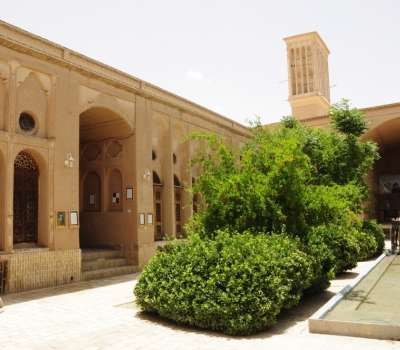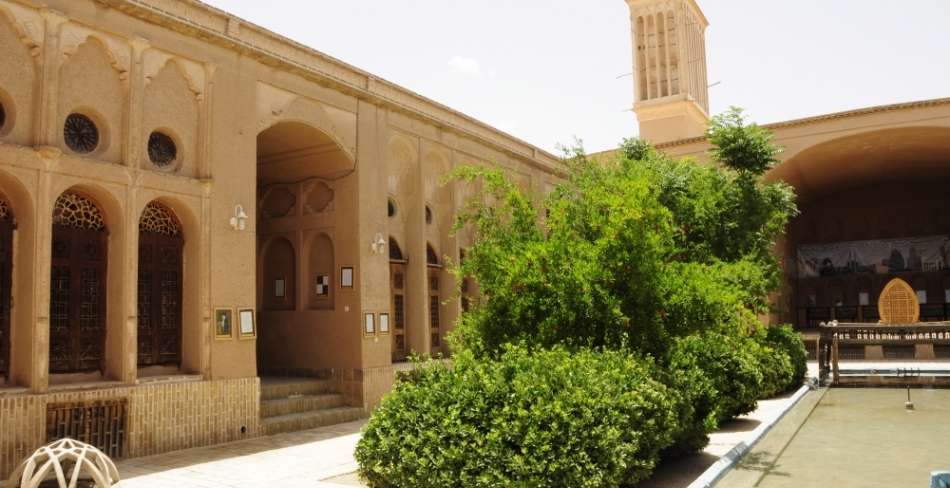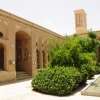

Yazd, A City of History
Yazd is the first adobe city and the second most historic city in the world. It is also the only Iranian city that has been registered in UNESCO as a World Heritage Site. Some sources attribute the early construction of Yazd to the time of Zahhak and some others refer to the time of Alexander the Great. They attribute Meybod to Solomon and Abarkuh to Abraham. This date reflects the historical and cultural background of the land and its people.
.jpg)
The Old City of Yazd
The historic town of Yazd with an area of approximately 800 hectares forms the most extensive, most original and untouched historical texture in Iran which has been registered with the registration number 1544 in world heritage list of UNESCO.
.jpg)
The unique architecture of traditional Yazd houses is one of the most prominent architectural examples of the warm and dry climate of the world, which, in addition to its beauty, is also suited to the needs of the people of the region and its cultural conditions. Generally, densely populated neighborhoods were constructed with abundant buildings which are usually tall in order to create the greatest possible shadow on the outer surfaces of houses as well as the passersby passing through the alleys.
.jpg)
In the center of each old neighborhood in Yazd, you can usually see a hosseiniyeh, a mosque, a small bazaar, a lard (seasonal market), small workshops, a water stream (for accessing to the qanat), a water reservoir, a hammam (public bath) and so on.
The district of Fahadan or Yuzdaran (the owners of cheetahs) that the local people call it Jangal (literally means Jungle) is the most prominent example of the historical neighborhood of Yazd over centuries which architectural style is very magnificent and beautiful.
.jpg)
Old Houses of Yazd Are a Blend of Art and Desert
The old and beautiful four-seasons houses of Yazd are built in the direction of Qibla and from the northeast to the southwest in order to use of the spaces better. In this way, the summer spaces and winter rooms are very efficiently located around the central courtyard. This means that in the summer, a very cool and pleasant part of the house is suitable for summer (summer houses) and in the winter, the other part is very pleasantly warm and suitable for winter (winter house).
.jpg)
The number of historic houses in Yazd is not few, and at least there are about 140 houses and mansions on the alleyways of its historical context. When you walk in the historical alleys of the old town, you can see lots of old houses opening with a valuable wooden door which always attracts your attention. These old houses of Yazd reflect the original Iranian architecture and show the glory of this historic city.
.jpg)
Some of these amazing houses in Yazd have their own artistic, architectural and historical features including Khan-e Lari, Arbabi, Rasoulian, Malekzadeh, Mortaz, and many more.
Architectural Style of Historical Houses in Yazd
In the architecture of the traditional houses in Yazd, privacy is considered as one of the most important principles. In this regard, the houses were perfectly built introverted by creating a female door-knockers (ring –shape with low-pitched sound) and a man (hammer shape with high-pitched ring) on the doors, Keryas (entrance to the house), Vestibules, corridors, tall walls and organizing various spaces around the courtyard.
.jpg)
Another feature of the old houses in Yazd is that the summer part is formed on the eastern side of the houses to receive the least amount of sun light. In this part, you can see the high vault and arranged rows of small porches. In addition to the above spaces, there are places like a vestibule, a traditional kitchen, a warehouse, a well room, baths, etc. on the eastern side of some houses.
The General Principles of Desert Monuments
• Being Located in the southern and south-eastern direction
• High-capacity materials encountering the extreme heat
• Bright and white view
• Arch and domed roofs
• Buildings are both underground and over-ground
• Compact Plan
Components of Old Houses in Yazd
The old houses in Yazd are very large and magnificent. Therefore, they have many components and parts including a doorway (the tiled arch over the door), a living room (the place of gathering of family members), a wind tower, a korsi room (the small room which is always warm), a Sardab (cold underground) and etc.
.jpg)
In front of the two-leaf entrance door, there is a platform on either side for passengers to rest or for new comers to wait. When you open the door, there is a vestibule separating the interior part and exterior part, each of which is connected to a courtyard through a corridor.
The door to the outer part of the house (birooni) opens to a vestibule (4 or 8 angled domed hall with several platforms). Then there are narrow corridors leading to multi-room halls, a chamber, a breakfast room, a water reservoir, and the servant room. These narrow corridors are maze-like in order to prevent looking inside the interior. Andarooni is also a hall with several five-door rooms (panjdari), shahneshin, which has a way to the kitchen and the warehouse.
.jpg)
The Role of Courtyard in Traditional Houses in Yazd
The courtyard in the houses is a complete indication of being introverted. It is located under direct radiation of the sunshine in the buildings. There are three types of central, Narenjestan and exterior courtyard. In Yazd, the courtyard in a house is a completely different and independent environment with an outer space that plays the role of communication between spaces.
Courtyards usually include some a small garden and a pond. This small garden, with its beautiful trees and flowers and a long pond, has made a lush green space for warm summer days in Yazd. In fact, the courtyard among the Yazd families is like a second sitting room, especially in pleasant desert nights when the warmth of the air reduces relatively. It's also a great place for sleeping in the open air, playing children, gathering family members and holding wedding ceremonies, religious parties and more.
.JPG)
Central Courtyard
The central courtyard in the houses of Yazd is the main space of the house, which is basically large and has pleasing relaxed atmosphere. The water pond is located in the middle of the courtyard and is surrounded by gardens full of compatible desert trees such as pomegranates, figs, grapes and pistachios which provide enough shade for the yard.
.jpg)
The people of Dar al-Ebade (the other title for Yazd meaning the place of worshipers), even in the architecture of their houses, consider the hijab (being covered from the strangers) as a very important factor. Though there is a vestibule, the hallway, the entrance, the tall walls; they keep the inner side of the house away from the visitors who are not allowed to see the family members.
.jpg)
The Outer Courtyard
The outer courtyard is another type of courtyard in the houses in Yazd. The rich families or business people used to build the outside courtyard as a place for their guests’ accommodations. Because having guesthouse in Yazd's residential architecture is a symbol of respect and honor to the guests. This courtyard was an exclusive courtyard, in contrast to the inner courtyard, it is a completely private and distinct area of the house.
Houses of merchants and clerics such as Malek Al-Tojar House, and Lari-ha House have exterior and interior courtyards due to their business needs.
.jpg)
Narenjestan Yard
The Narenjestan courtyard in Yazd houses has some other names like miansara or the small courtyard. In some houses, it is a covered small courtyard with some trees like sour orange trees (Narenj) and flowers like jasmine.
Badgir ( Wind tower )
The most prominent image of the city of Yazd is its special desert architecture which can been seen with the view of badgirs (wind tower), minarets and domes. Among these elements, wind towers are one of the most important elements of traditional architectural style of Yazd that you can normally find one in every traditional house of the city. The name of wind towers is strongly tied to the name of Yazd in a way that the city is nicknamed as the City of Badgirs. The loftiest and the most magnificent badgir in the world is the badgir in Dolat Abad Garden with a height of 33.8 m which is a masterpiece of engineering and genius of the Yazdi architects in old times.
Since Yazd is located between two mountain ranges, there blow fewer desert winds in it. Thus ancient architects in Yazd built four or eight-sided badgirs to take the wind inside and send it into the main rooms of the building, the water reservoir, or the cellar. As a badgir is located over the roof of the buildings, in this way, cool wind enters different parts of the house making the building cool and ventilated.
In some of the wind towers, cooling the building is done through air displacement, and in some others, both by air displacement and evaporation. In this way, the flow of air passed over a small pond with a fountain to the other parts of the house. In hot and dry areas in central Iran, since the weather is dry, the water is evaporated more quickly and increases the humidity of the weather and reduces the heat. On the other hand, the wind coming down from the badgir moves this cooled air all through the building.
The other characteristic of the badgirs is the chimney effect; in a way that in the absence of wind flowing, the badgirs send the hot air inside the house upwards and outside the building and form the flow of air, although its intensity of the flow of air is much less than that of the time of wind blowing.
Badgirs were also used to keep the food cool.

Summer Parts of the House (in the Eastern Part)
• Hoze Khane (pond room, a room with a pond inside under the badgir)
• Underground
• Payab (cool room on the qanat passageway)
• Talar (a decorated hall for guest catering)
.jpg)
Winter Parts of The House (in the Western Part)
• Korsikhane (a room containing a brazier)
• Five-door room (pannjdari)
• Three-door room (sedari)
• Upstairs
• Teharni (Orsi room with lattice sash windows and doors)
Orsi rooms are those rooms which doors open and close vertically. So when the door is open, no one can see the leafs of the door and it seems the room is always open. So they call them orsi rooms (literally means open rooms).
.jpg)
To experience visiting these elements of history and architecture, you can book a sightseeing tour where you can learn more and more about traditional houses in Yazd and their unique architecture.












.jpg)
.jpg)
.jpg)
.jpg)
.jpg)
.jpg)
.jpg)
.jpg)
.jpg)
.jpg)
.jpg)
.jpg)

.jpg)
.jpg)

